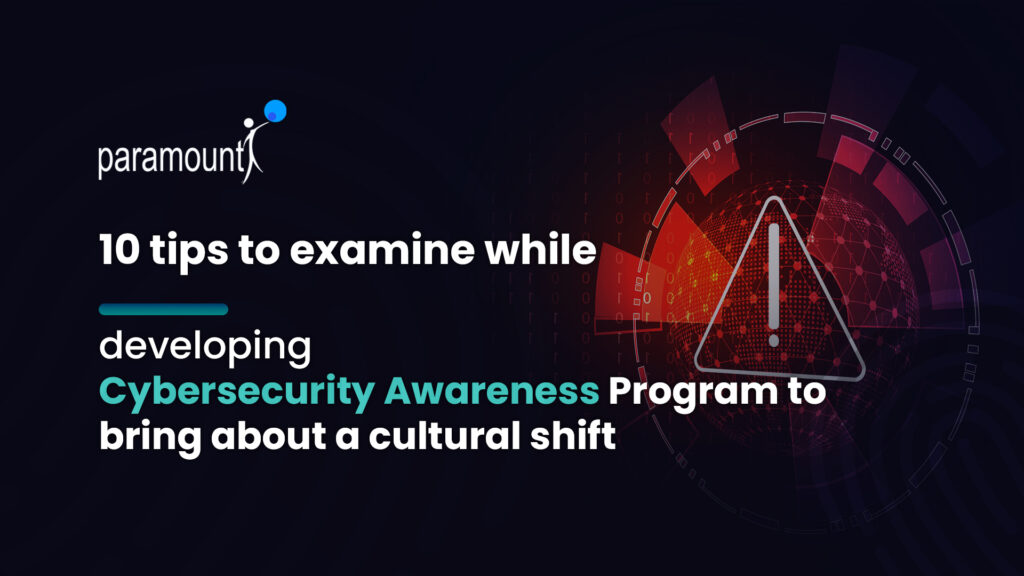Insights
10 Tips to examine while developing Cybersecurity Awareness Program

Yes humans err, but these errors can lead to extremely expensive outages and the loss of significant customers. Are you ready for such costly errors that expose your organization to high risk?
According to the World Economic Forum, 95% of cybersecurity issues are traced to human errors. Whether it is clicking a link or downloading or missing an update, which is unintentional, can jeopardize a company’s security system.
Rather than just enforcing security regulations, or forcing employees to pass a mere security test, it becomes imperative to put oneself in the employee's shoes and think, “What makes humans vulnerable to cyber-attacks?”
It is a call for Human and Risk Management (HRM) leaders to take a human-centric approach while developing Cyber Security Awareness Programs rather than just a tick-in-the-box.
Cyber Security Awareness Program should aim at creating a paradigm shift in the
organization’s culture, which in turn instills a behavioral change in each and every employee so much so that the security practices are instinctively followed in their daily life.

Here are 10 tips to consider while developing Cybersecurity Awareness Program to bring about a cultural shift:
- Foster a security culture: The program should not be just a check in the box, but rather move from cyber awareness behavior to being ingrained as a culture. Cyber security culture refers to the norms, ethics, knowledge, attitude, and social behavior of the employees of an organization. And these have to be aligned with organizations’ goals of cyber resilience. Further, a top-down approach will help to inculcate a sense of cyber awareness culture. If the policies do not work at the board member level, they probably may not work with others further down the organization.
- Make it a habit: Aligning organizational goals with individual values can be successful when it is made a habit. Once a year training program does not work. Regular training programs will enable to change people’s behavior toward identifying cyber threats. Creating a strong password, regularly updating the system, learning about the latest threats, being aware of malicious links, and being attentive to anything suspicious should become a habit.
- Values and Norms: Understanding the organization’s vision on cybersecurity policies and compliance, and instilling those values and norms among every employee will foster a behavioral shift. Promote ethical behavior and integrity as non-negotiable aspects of the culture. These values should guide decision-making and behavior at all levels. This makes employees feel engaged and committed to the organization, and they feel less pressure to compromise the organization’s standards.
- Understand end-user constraints: Understand and be empathetic to end-user constraints – such as their goals, timelines, pressures, distractions, and their state of mind while the threat is just a click away. Lack of awareness and training, the complexity of security measures, lack of easy access to necessary cybersecurity measures, resistance to change if it disrupts their routine, different levels of tech-savviness, etc., have to be considered while creating a cyber awareness program.
- Learn with fun: Say goodbye to those boring tests to be cleared. The cyber security program should be appealing and register in their mind. This can be done when learning is made fun. Provide hands-on training, quizzes, games, digestible flashcards, and emailers, visual learning will enable learning engaging and enjoyable. Leverage real work scenarios about security threats and their impact, cautionary tales that resonate with the audience and among others will help to create heightened awareness.
- Inclusivity and Diversity: An inclusive cybersecurity culture enhances security practices and motivates employees to protect the organization from cyber threats. The feeling of inclusion, connection, and identification that employees have with the organization’s cybersecurity goals and practices plays a crucial role in thwarting cyber threats. When employees feel a sense of belonging in the cybersecurity culture, they are more likely to actively participate in and contribute to security efforts.
- The loneliness paradox: Cross-functional collaboration between the security team and other departments will reduce isolation. Collaboration between the security team and other departments, such as IT, HR, Legal, and management can lead to a robust and more effective security posture.
- Positive Cyber Security Environment: A supportive environment enables employees to take proactive measures against cyber threats. Encouraging proactive risk management, empowering employees to report potential threats, well-documented incident response plans, conducting regular drills, etc., should foster a cybersecurity awareness culture of collective responsibility to mitigate risk.
- Clear Communication: With over 90% of cyber security issues having a human element, it is the people rather than technology that makes the organization secure. Thus, let each employee understand that their role in cyber security is primary and not secondary.
- Mature Cyber Security Culture: Consistency leads to improved cyber security maturity, as employees are empowered to counter any cyber-attack.
Recent Posts
- Generative AI adoption risks you should address to safeguard your enterprise
- Cybersecurity Lessons from the Cyberattack on MGM Resorts
- 10 Tips to examine while implementing zero trust model
- IT/OT convergence a way forward towards robust OT security system
- History of DNS Abuse Attack Vector & Countermeasure
- Ransomware attack on Chinese bank’s US subsidiary another warning signal
- Why is choosing the Right Security Operations Center Necessary?

